The ongoing Lightweight Machine Gun-Medium (LMG-M) competition by USSOCOM continues the movement of U.S. forces to a new family of small arms weapons chambered in 338 Norma Magnum. The push for a 338 NM machine gun comes after the 2021 adoption of the Barrett Firearms MRAD rifle as the U.S. Army’s MK22 Precision Sniper Rifle (PSR), and the fielding by SOCOM of the 338 NM/300 NM/7.62 NATO rifle as its Advanced Sniper Rifle (ASR). The LMG-M competition comes on the heels of the 6.8mm Next Generation Squad Weapon (NGSW) award to SIG Sauer. That competition started as a herd of nearly a dozen competitors and was down-selected to three: SIG Sauer, True Velocity, and AAI/Textron. This next competition for SOCOM’s lightweight medium machine gun includes SIG again and the field is rounded out by True Velocity/Lonestar Future Weapons and Ohio Ordnance Works.
The purpose of the LMG-M is to bridge the gap between the M2 and M240 machine guns. The program’s objectives are to deliver a man-portable system that has overmatch capability over opposing enemy 7.62x54R machine guns. The LMG-M’s performance should be close to that of a .50 caliber machine gun in terms of engagement distance, however, the smaller 300-grain projectiles used in the 338 NM will not have the kinetic energy of a 660+ grain projectile fired from a 50 BMG. In addition, there is a growing need for lightweight systems for aircraft and side-by-side type vehicles. In many cases, these heavy gun systems exceed the total system weight (weapon, ammunition feed systems, and ammunition) allowable for operation on these vehicles. They need a lighter-weight option going forward.
To understand the program’s objectives, let’s take a closer look at the systems the LMG-M is designed to replace.
OLD FAITHFUL – THE M2 MACHINE GUN
The LMG-M system is designed to replace John M. Browning’s masterpiece, the .50 caliber/12.7x99mm M2 (“Ma Deuce”) heavy machine gun. This iconic weapon has dominated the battlefield for the last 91 years. It’s been in service since 1933, with no end in sight. “Replace” is probably not the right word. As mentioned, the U.S. M2 will be around for the foreseeable future. The .338 LMG-M is going to replace it in some applications. Why? Because the LMG-M is going to be around 25 pounds versus the 84 pounds of the M2. That’s nearly a 50-pound difference. A complete M2 system including optics, M3 tripod, spare barrel (required because of heat issues), and 400 rounds of ammunition weighs 288 pounds. This is clearly not a single-man portable system; it takes a small team to utilize this weapon.
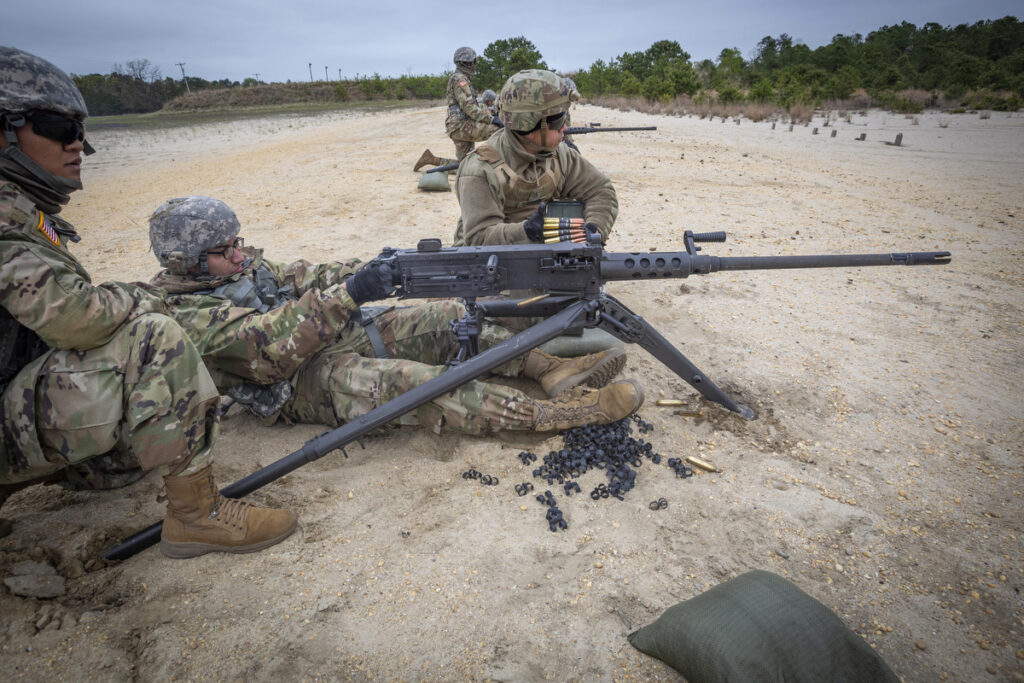
In a vehicle situation where 4000 rounds are likely present, you now have 1320 pounds of ammo. This additional weight is not an issue in an Abrahams tank, however, it is a no-go for smaller vehicles and modern side-by-sides. Next, of course, is aircraft. This system is far too heavy for many small aircraft and helicopters. I’m sure drones will come into the conversation here too. The M2 and 1320 pounds of ammo is probably a no-go scenario for a typical drone, however, a lighter LMG-M with lightweight ammunition is a different story.
| M2 Machine Gun Specifications | |
| Caliber | .50 BMG / 12.7x99mm |
| Weight | 84 lb. |
| Length | 68 In. |
| Rate of Fire | 550 rounds/min |
| Max Effective Range | 2000 m |
| Muzzle Velocity | 2910 fps |
| Max Range | 6791 m |
| Total Combat Weight w/400 rounds | 287.5 lb. |
| Team size | 4 to 9 |
The LMG-M concept is man-portable and considerably lighter, a boon not only for infantry, but for other weight-conscious applications such as in aircraft, boats, or vehicles. The weight of the machine gun and ammo makes a very compelling argument for a lighter-weight weapon and ammo.
LIGHT AND PORTABLE – THE M240 MACHINE GUN
To go a little deeper into history, we need to also discuss the U.S. M240 machine gun in 7.62x51mm. This is the little brother to the .50 cal M2. The LMG-M will become the middle child in the family and have middle child syndrome to boot. The LMG-M is also going to partially replace the M240. Just as with the M2, we foresee the M240 being around for a very long time. The M240 fires the 7.62x51mm cartridge. The M240 has been in service since 1977 and was an upgrade for the prior M60 that was in service since 1957. This system is man-portable and vehicle- and aircraft-mountable. A complete system for this weapon including optics, M192 tripod, spare barrel, and 800 rounds of ammunition is 101 pounds, making it very possible to carry in a multi-person team.
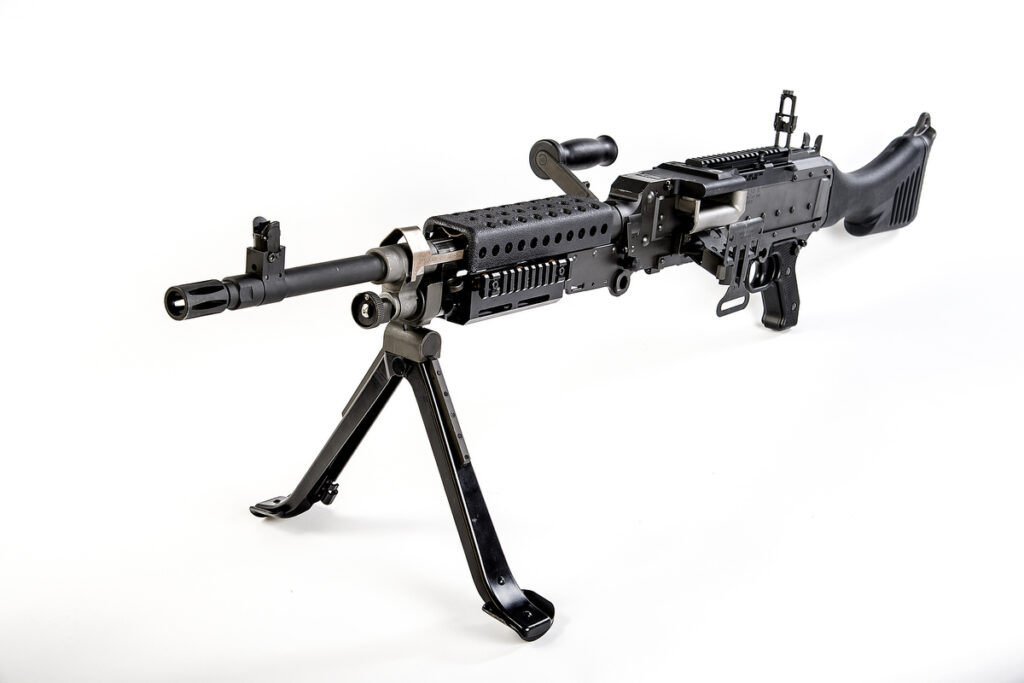
| M240 Machine Gun Specifications | |
| Caliber | 7.62x51mm / 308 Winchester |
| Weight | 27.6 lb. |
| Length | 49.7 in. |
| Rate of Fire | 650 rounds/min |
| Max Effective Range | 800 m (bipod) 1100m (tripod) |
| Muzzle Velocity | 2800 fps |
| Max Range | 5642 m |
| Total Combat Weight w/800 rounds | 101 lb. |
| Team size | 3 |
THE OVERMATCH PROBLEM
In the U.S. war in Afghanistan, the troops on the ground had a major problem. These teams would come up against the enemy with the non-standard PKM machine gun firing the 7.62x54mm R caliber (R= rimmed for the protruding rim from original cartridge designs to be easier to extract) that has an effective range of 1500 meters. Troops equipped with this weapon had overmatch capability on U.S. and NATO forces. This has been a known issue for decades, however, the U.S. has been involved in few conflicts where it was a major issue, as it is in the open deserts of Afghanistan.
The overmatch issue is probably driving about 60-70% of the need for the LMG-M. The other 30-40% is the need to reduce the weight of the current machine gun for use in numerous vehicles, boats, and aircraft. A modern, lightweight attack vehicle could not handle carrying a .50 caliber system with 1000 rounds of ammo. Included in that percentage is the capability to be single-man portable, where something in the target weight range would be mission-changing.
Since we are talking machine guns, it’s appropriate to include in our comparison the Soviet-era PK machine gun our allied forces face in the field. The original PK has been in service since 1961. It was designed by probably the world’s number two machine gun designer (after Browning), Mikhail Kalashnikov. The improved PKM variant went into Soviet service in 1969. There are nearly eight variants. It has seen action in as many as 36 conflicts around the globe. The fully equipped weapon is estimated to weigh 65 pounds with bipod, optic, spare barrel, and 800 rounds of ammunition.
| PK Machine Gun Specifications | |
| Caliber | 7.62x54mm Rimmed |
| Weight | 20 lb. |
| Length | 47.4 in. |
| Rate of Fire | 650 rounds/min |
| Max Effective Range | 1500 m |
| Muzzle Velocity | 2800 fps |
| Max Range | 4000 m |
| Total Combat Weight w/800 rounds | 65 lb. |
| Team size | 2 |
THE OBJECTIVE OF SOCOM’s LMG-M PROGRAM
The objectives of the LMG-M program are as follows; to supply a lightweight medium machine gun with the following capabilities and features:
- Weight less than 31.1 pounds (threshold) and (objective) 23 pounds with fully equipped with rail, handle, bipod, buttstock, and suppressor.
- Length less than 61 inches (threshold) and (objective) 56 pounds with fully equipped with rail, handle, bipod, buttstock, and suppressor.
- Barrel changes without tools in less than 10 seconds (threshold).
- Minimum velocity of 2400 fps.
- Trigger pull between 8 and 16 pounds.
- Average mean radius (accuracy): single shot not to exceed 6 MOA (threshold) and 3 MOA (objective)at 100 meters.
- Cyclic rate of 450-750 rounds per minute (threshold) and 550 +/- 25 rpm (objective).
- Capable of 125 rounds at a maximum rate of fire without catastrophic failure both unsuppressed and suppressed.
- Recommended 1:8-inch twist.
- 8,000 round barrel life (threshold) and 15,000 (objective).
Keeping in mind that the U.S. government often asks for near-impossible things, it’s doubtful that any weapon will meet all of these criteria 100%. Then it becomes a guessing game about which of the criteria is deemed more important. For example, would a shorter weapon that is lighter, however less accurate, be preferred over a longer, heavier, and more accurate weapon? How much weight and length are worth the potential sacrifice? The government typically uses a matrix. The scoring parameters and the value of particular scores can only be guessed, depending on the winners and losers.
THE CURRENT CONTENDERS
The LMG-M contract competitors are (in alphabetical order):
- True Velocity
- Ohio Ordnance Works
- SIG Sauer
THE CURRENT STATUS OF THE PROGRAM
Back in 2020, SIG Sauer’s MMG 338 passed safety certification and the company delivered a small quantity (estimated at 8 to 12 units) to SOCOM. These were early weapons to evaluate. It seems like there was a period when the manufacturers were willing to let the government evaluate the weapons while they still had time to make changes. It appears that, over the last several months, the competitors have been more secretive about the status of their weapons.
The program was held up waiting for ammunition to be used to evaluate the machine guns. The delay was due to projectile issues, COVID-19-related issues, and vendor changes. The government believed that they needed their ammunition to fairly evaluate the machine guns. This is probably a good idea in general, as most of the manufacturers might have their weapons function with ammunition of their choosing and maybe not function as well with another type of 338 ammunition. However, the links are different for all three manufacturers’ weapons. However, I’m told that all the links are close enough that they “should” run in the competitors’ weapons. Nonetheless, no one is going to take that chance in a competitive environment.
During the SOFWEEK conference In May 2023, Lt. Col. John “Tosh” Lancaster, program manager for U.S. Special Operations Command’s lethality acquisitions, told Defense News that the lightweight medium machine gun is scheduled to field in fiscal 2026. He also told the outlet that SOCOM is still actively looking for the accessories and suite of ammunition needed for the weapon.
Back on February 7, 2024, the competitors delivered three weapons. As of April 30th, 2024, the competitors will need to deliver a total of 12 weapons for a 10,000-round endurance test. Supplied kits included a conversion barrel to 7.62x51mm and testing for this was an “indeterminate” amount. I assume this means more than the 10,000 338 Norma Mag rounds. They also were required to submit 125,000 bare links to run the unlinked 338 Multipurpose ammunition delivered by UDC USA in support of this contract back in 2022-2023. The manufacturers are also to provide the complete technical data package (TDP).
Now, here’s a breakdown of the companies and weapons that have been submitted to SOCOM for its LMG-M contract.
TRUE VELOCITY RM 338
True Velocity, known for its lightweight ammunition, has the oldest design in the field. The company is in Dallas, TX. Their weapon is the RM 338 for Recoil Mitigation.
The True Velocity contract entry was originally designed and built by the General Dynamics Saco facility back in 2012. To GD’s credit, it saw a capability gap between the 7.62×51 M240 and the non-standard PK machine gun. In around a year, the company developed its weapon, an amazingly fast task for a big, slow-turning ship like GD. However, GD was not rewarded for its Herculean effort. The product of its labor was on display at trade shows for several years while the overmatch issue was hotly debated through 2016. Then, the weapon went out of the public eye for a year or two. Once SOCOM started talking about the LMG-M requirement in around 2017, GD’s machine gun was back in the spotlight. It was part of a Combating Terrorism Technical Support Office (CTTSO) Irregular Warfare project from several years ago.
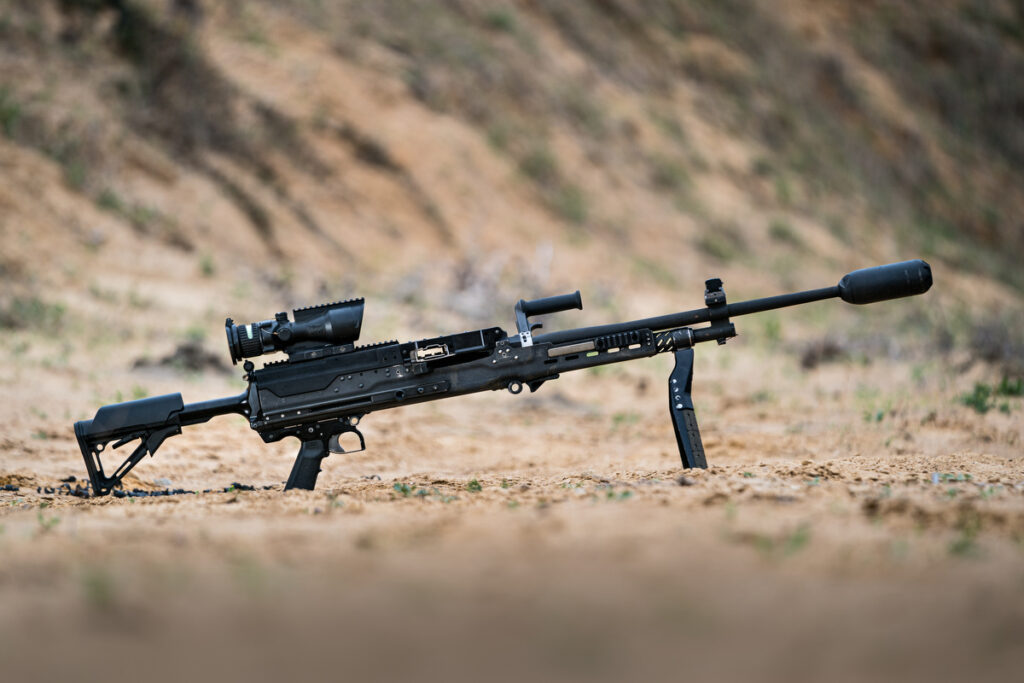
True Velocity acquired the rights to GD’s weapon system in the 2021 timeframe and, soon after, started a sister company that you might have seen associated with the company’s machine development gun effort, Lone Star Future Weapons. This is more of a holding company set up by True Velocity to house the machine gun’s intellectual property.
This weapon visually resembles a slightly upsized M240 Bravo. This is a tried-and-true weapon system. The receiver assembly, cover plate, barrel assembly, and trigger housing assembly all look similar to the M240. The recoil mitigation system is impressive. True Velocity is proud that an operator can fire the RM 338 on targets at 1500 meters and continuously see the point of impact. They say they can also walk and fire the weapon. It’s an amazing weapon and is a serious contender. Its age makes it a little less interesting because it’s been around nearly forever. However, its maturity is a great thing for conservative, risk-averse government selection teams.
The weapon, fully equipped for combat with optics, an M192 tripod, a spare barrel, and 500 rounds of linked ammunition weights 102.7 pounds. Note, this is the weight with the 300-grain projectile, while SOCOM’s multi-purpose ammunition is 272 grains. Running the government ammo will reduce the overall load by two to three pounds for the 500-round load-out.
| True Velocity RM338 Specs | |
| Weight | 25 lb. |
| Length | 49 in. |
| Rate of Fire | 500+ rounds/min |
| Max Effective Range | 2000 m |
| Muzzle Velocity | 2650 fps |
| Max Range | 5642 m |
| Total Combat Weight w/500 rounds | 103 lb. |
| Team Size | 3 |
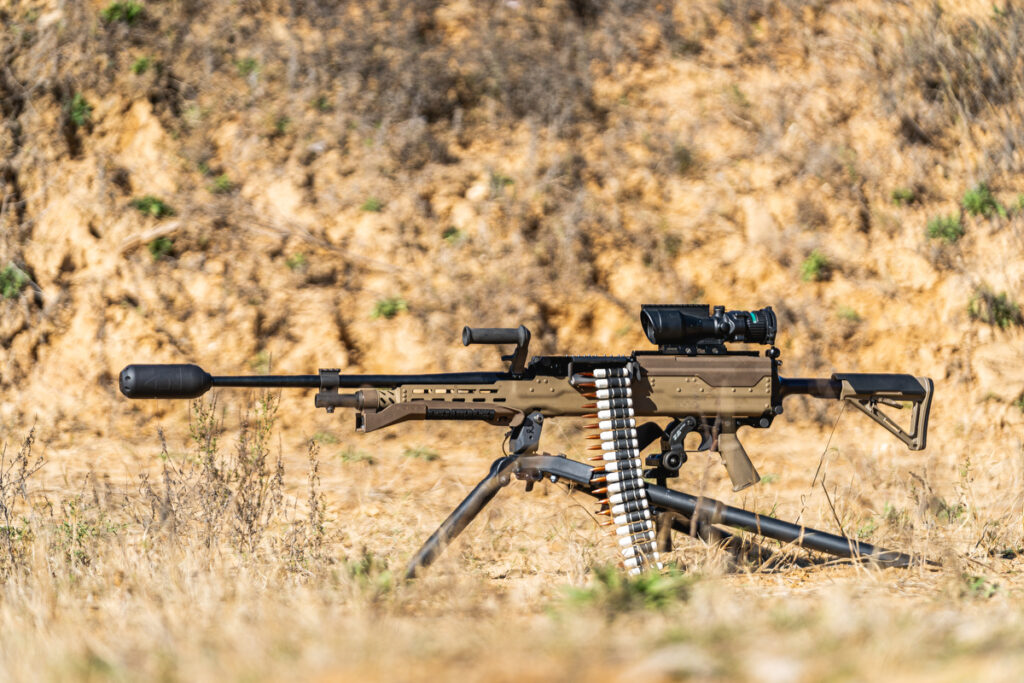
I had the pleasure of firing the True Velocity RM 338 in Las Vegas in April 2022. It’s an impressive weapon. The recoil was very minimal. It cycled like a champ. It seemed accurate; however, we were not shooting on paper, so accuracy was hard to gauge. It feels very familiar to standard machine gun designs. I’m told that it’s had millions of rounds fired through it over the last 12 years. It’s going to work, and work well.
An interesting point is their connection with polymer ammunition. SOCOM originally expressed an interest in lightweight ammo to go along with the weapon. They have placed this desire on hold for now. To meet government standards, qualification of the lightweight ammo could take years (or decades) depending on the approach.
As a salient aside, three weeks ago, True Velocity filed a lawsuit against SIG Sauer in Vermont’s Chittenden Superior Court alleging SIG Sauer stole True Velocity’s recoil mitigation concept by hiring its former employees and used it in its SIG-MMG 338 SOCOM LMG-M submission.
OHIO ORDNANCE WORKS REAPR
Ohio Ordnance Works (OOW), located in Charon, Ohio, was the third company to enter the competition. It specializes in making numerous machine guns, including the M240 and the M2. So, the company is highly qualified and has been around since 1992, pointing to them as a well-established, reliable contractor in the arms manufacturing space. This is a major move for OOW since they traditionally manufacture older designed weapons. Their efforts started before 2020 when patents were filed.
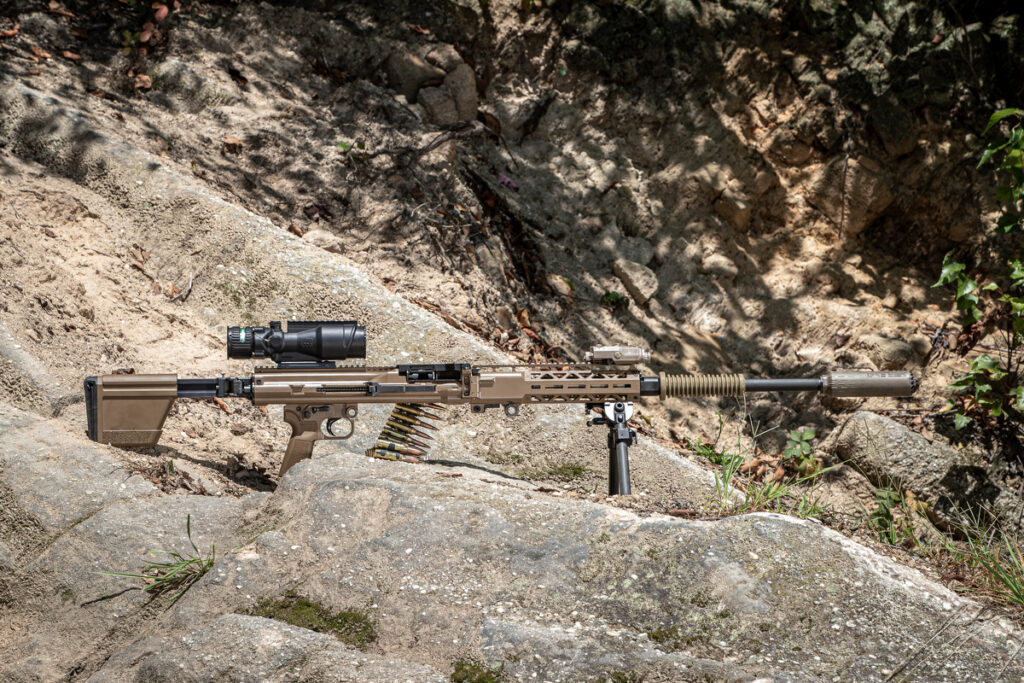
The machine gun is called the Recoil Enhanced Automatic Precision Rifle or REAPR, for short, and its design is pretty impressive. The patented sliding feed tray is unique and purposeful. It’s so unique that it is going to need a lot of testing for the government to feel comfortable with it. It’s probably a game-changer. Having tons of optics mounted and never moving them is a huge deal. Per OOW staff, this gives them the most rail space of any of the guns in the competition. The other big win is the breakdown into three pieces to be backpack-carriable. The barrel is just under 25 inches (and would be the longest part), so we are not talking about a giant pack, here. That makes this a one-man system, with a small load of linked ammunition.
I got behind a gun at a special event in Las Vegas in April 2022. It’s really impressive. I know they have fired a ton of ammo over those last few years, so they are trying hard to catch up to the time the other systems have in the space. It seems like they have closed the gap. They fully released the weapon as the REAPR at SHOT 2024. This was strategic to ensure none of its competitors could copy anything from the weapon before the submission was due a very short time later. It is currently capable and has been fired in 338 Norma Mag and 7.62x51mm.
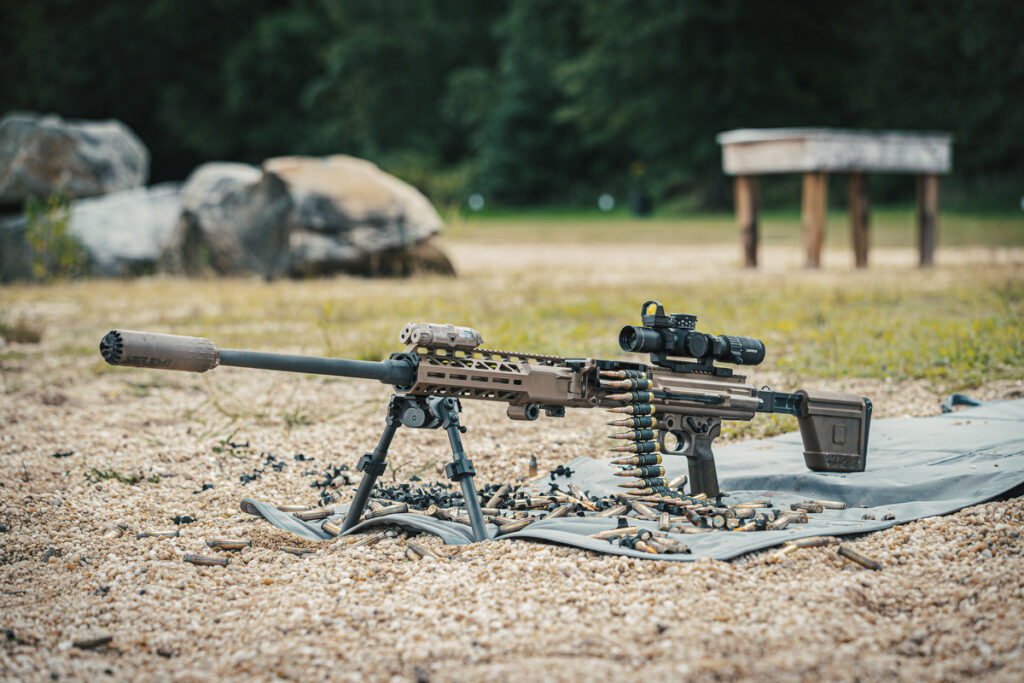
| Ohio Ordnance REAPR Specs | |
| Weight | 26.8 lb. |
| Length | 54.5 in. extended Stock, 44.25 inch folded |
| Rate of Fire | 550-650 rounds/min |
| Max Range | 6,700 m |
| Muzzle Velocity | 2650 fps |
| Max Range | 5642 m |
| Team Size | 1-2, Backpack Portable |
SIG SAUER SIG-MMG 338
SIG Sauer, Inc. was the second company to enter the competition with its SIG-MMG 338. It has two New Hampshire locations for weapon manufacturing and an Arkansas facility for ammunition manufacturing. SIG Sauer was founded in 1976 in Germany. The original SIG Sauer has undergone several corporate transformations and is now two independently operated brands owned by the German management group L&O Holding; the small Swiss manufacturer, SIG Sauer AG, and the much larger American firearm manufacturer, SIG Sauer, Inc. All references to SIG Sauer in this article point to the American company, SIG Sauer, Inc.
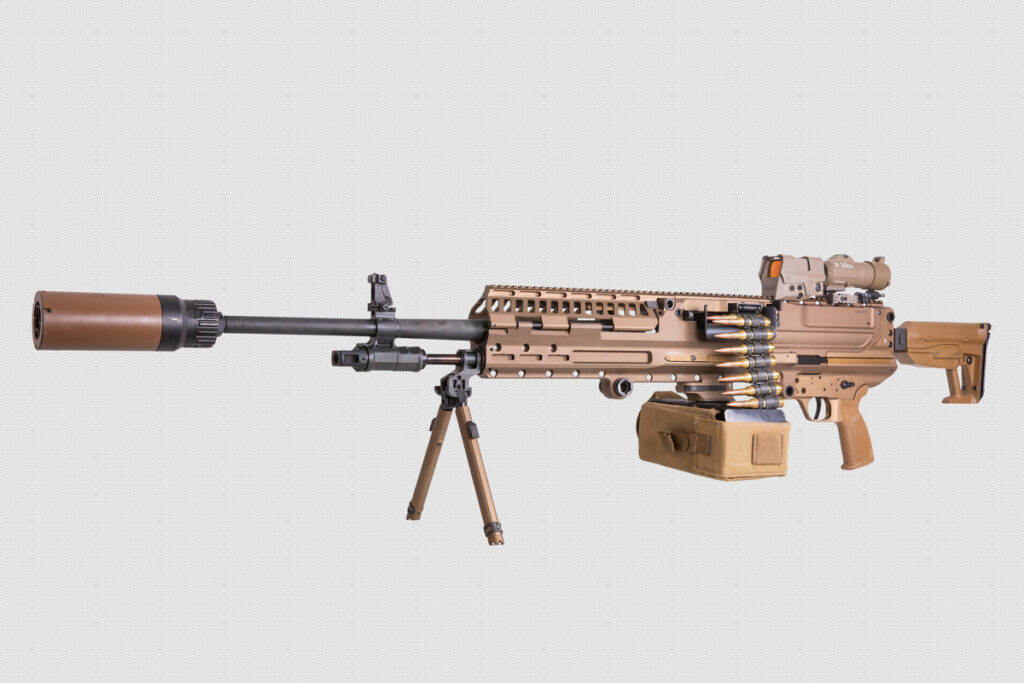
The weapon seems like a cross between an M240 and other modern SIG weapons. It does have a short-stroke gas piston system and a SIG proprietary recoil reduction system. In a deviation from the standard M240 style cover, the feed tray cover is a side-opening. This has advantages over non-moving optics. It has other modern features like a folding stock, a quick-change barrel, and a compact suppressor.
SIG had already provided samples to the government in early 2020. It’s been demonstrating the weapon at numerous range events around the country. I was able to shoot the weapon in Las Vegas in April 2022. It’s an impressive weapon with reasonable recoil. Unfortunately, the machine gun’s accuracy was hard to evaluate since we were not shooting paper targets. The gun functioned flawlessly. The only complaint I have concerns the suppressor and all the gas blowing back at the shooter. This can be addressed with a different suppressor. All the demos and public exposure have SIG’s effort positioned in the early lead of the competition. Their SIG-MMG 338 has had lots of public exposure in the last few years.
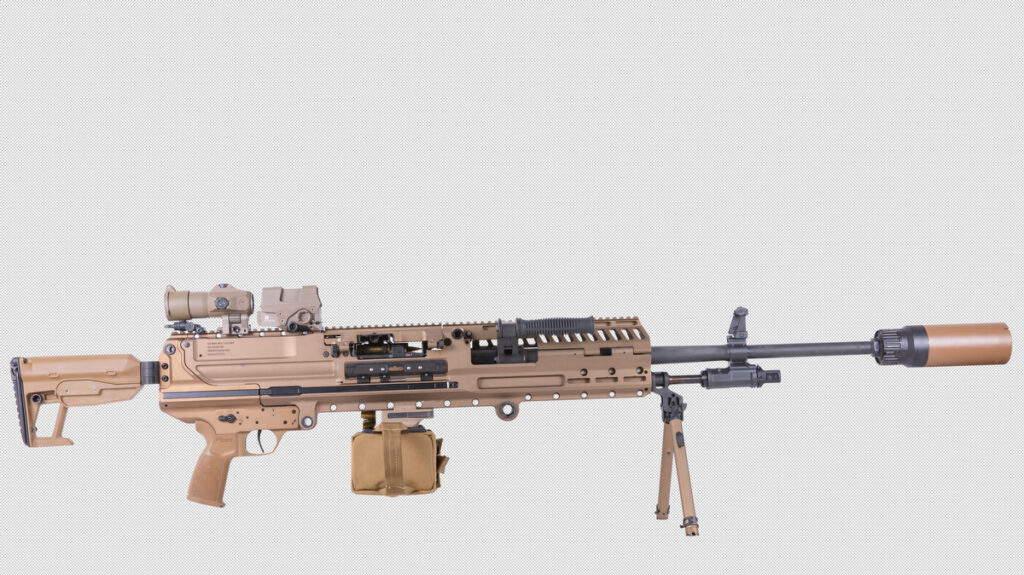
| Sig Sauer SIG-MMG 338 Specs | |
| Weight | 24.1 lb. |
| Length | 50 in. (Unclear what this includes) |
| Rate of Fire | 600 rounds/min |
| Max Range | 5,640 m |
| Muzzle Velocity | 2650 fps |
| Max Range | 5642 m |
| Team Size | +/- 2 |
KEY TAKEAWAYS
This will be a tight competition. It will not be as well-publicized (because of the limited field of expertise in machine guns) as the 6.8 NSGW competition, nor will its outcome have the battlefield impact of replacing the entire suite of squad-level weaponry. However, it will still have a large impact on the way the battle is conducted in the future.
Why would True Velocity win? This weapon has 12 years of extensive General Dynamics-style development, testing, and evaluation. It has the longest history and the most amount of rounds down the barrel. If SOCOM wants tried and true, tested, and run to its limits again and again – this is the choice. If SOCOM is really interested in fielding lightweight ammo, True Velocity’s ability to leverage its lightweight ammunition may give it an edge in the competition. There are very few lightweight ammunition options in 338 Norma Mag.
Why would Ohio Ordnance Works win? Its very innovative design, reliability, and extensive experience with belt-fed machine guns are the company’s hallmarks. There are a lot of very nice features, like the sliding feed tray that allows nearly any optic to be placed upon it. Also, there is the one-handed barrel change. Are these “unlisted” items enough to sway SOCOM?
Why would SIG Sauer win? It has a solidly performing weapon and a compelling history of producing weapons under military contracts. It also has a history of treating its major U.S. government contracts as loss leaders, pricing them aggressively and leaving thin margins that it offsets with profits on commercial, international, and other agency sales.
CLOSING
The biggest winner will be the U.S. warrior. Some don’t see the benefit of this system. I 110% see it changing the way warfare takes place. Imagine a single soldier or operator being able to sneak up and lay suppressed suppressive fire on targets 3000+ meters away, then pack up and be gone before the enemy has any idea where it came from. Then repeat 30 minutes later. What it will do for aircraft will be similarly impressive. Longer distances with a lighter weight system.
Some minigun systems may get switched out to the 338 LMG-M due to the weight savings (50 pounds), lesser cost, and greater downrange effects. It’s a long shot. However, it could happen. This will probably be impacted by the future of the 338 Norma Magnum suite of ammunition and the capabilities it provides.
It will be impressive. It will make a difference. It will be the future. It might have 90 years of service life like the M2. This future date is 2114. They should have phasers or laser guns by then, however, I’m sure someone back in 1933 thought we’d have lasers in 2024.





